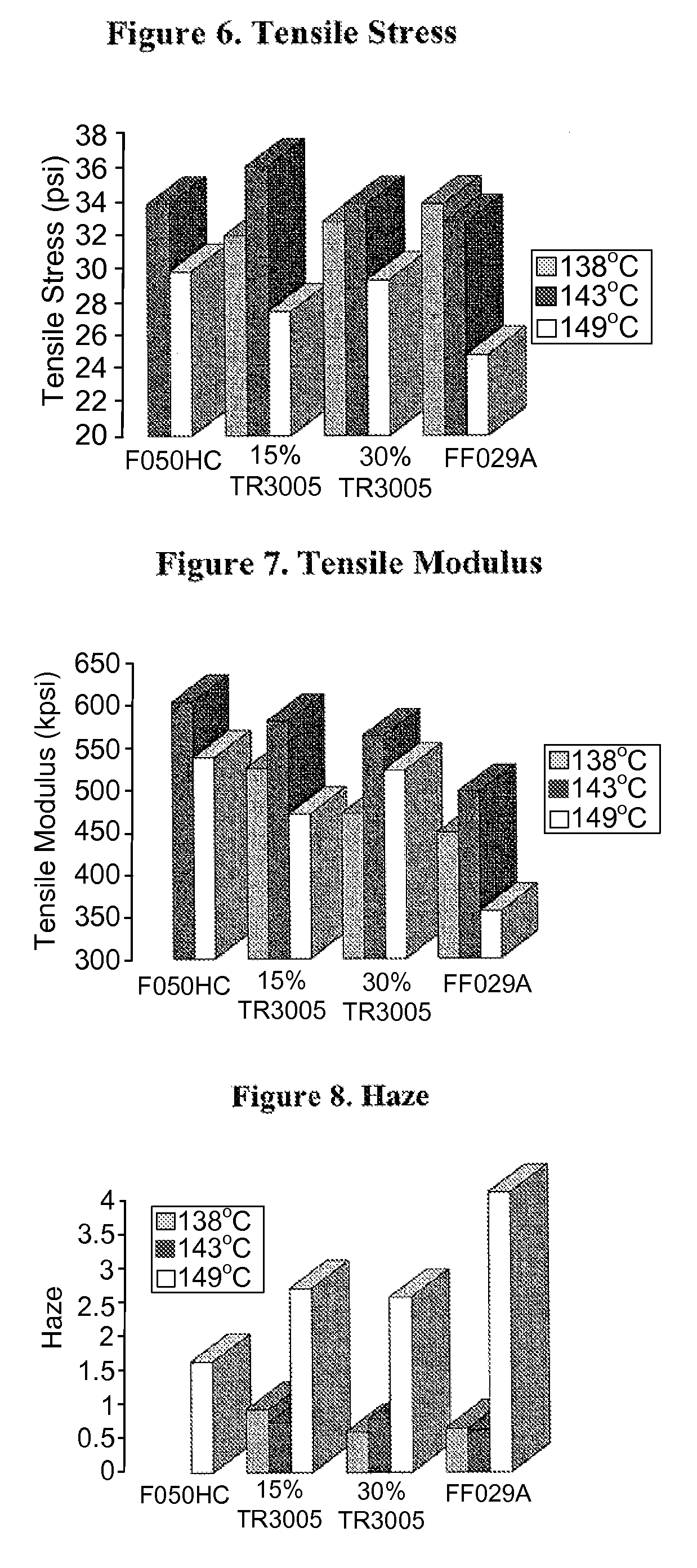Polypropylene blends for non-woven production
a technology of polypropylene and non-woven fabrics, which is applied in the field of polypropylene blends, can solve the problems of reducing affecting the production efficiency of pp manufacturers, and compromising the barrier properties of fabrics, so as to improve the soluble content. , the effect of reducing the soluble conten
- Summary
- Abstract
- Description
- Claims
- Application Information
AI Technical Summary
Benefits of technology
Problems solved by technology
Method used
Image
Examples
example 1
Conventional Polypropylene in BOPP Film
[0048]Several samples of a resin blend according to the current invention were prepared using a conventional non-BOPP grade polypropylene homopolymer having low solubles. Polypropylene homopolymer, D022D, available from Sunoco, was melt blended with various amounts of a random copolymer resin having 2.5% ethylene, TR3020F, available from Sunoco. A commercial BOPP grade polypropylene, FF020D, available from Sunoco, containing relatively large amounts of xylene solubles, e.g., 4.9%, was included for comparison. The various blends prepared are shown in Table 1.
TABLE 1Compositions PreparedResinABCDEFD022100959080TR302051020100FF020D100
[0049]The melt flow rate (MFR) and the contents of xylene soluble were determined by the method prescribed in ASTM 1238 and 5492, respectively. The molecular weights were determined by high temperature size exclusion chromatography (HSEC) at 140° C. For thermal characteristics, DSC (Differential Scanning Calorimetry) ...
example 2
High Crystalline Polypropylene in BOPP Film
[0055]A second set of compositions was prepared using a high crystallinity polypropylene homopolymer, F050HC, available from Sunoco. The random copolymer, TR3005, available from Sunoco, having 2.5% ethylene, was melt blended with the HC homopolymer via compounding as given in Table 6. A conventional BOPP material, FF029A, available from Sunoco, designed for the core material of clear film, was used as a control.
TABLE 6Compounds prepared in this study2100944ABCDF050HC %1008570TR3005 %1530FF029A (31J026)100
[0056]The melt flow rate (MFR) and the contents of xylene soluble were determined by the method prescribed in ASTM 1238 and 5492, respectively. The molecular weights were determined by high temperature size exclusion chromatography (HSEC) at 140° C. The melting temperature and recrystallization temperature for each composition was determined using annealed differential scanning calorimetry (ADSC). The polymers were melted at 230° C. for 5 m...
example 3
In-Reactor Blending
[0070]Polypropylene homopolymer was continuously produced at 70° C. in a first stage polymerization using two loop reactors by using a catalyst system (catalyst, co-catalyst and external donor) that provides relatively high isotacticity, followed by production of 10-20 wt % random copolymer containing 2.5 wt ethylene in a second stage gas phase reactor. The propylene monomer was fed the loop reactors at a rate of 80 kg / h while maintaining 700 ppm H2 and the density of 560 g / l. The homopolymer was continuously transferred to the second stage gas phase reactor where the random copolymer was produced. To produce the random copolymer, both ethylene and propylene at 0.03 mol % gas phase ratio (C2 / C2+C3) and 0.015 mole % H2 were fed to the gas phase reactor. The characteristics of the in situ polymer blend produced in the continuous reactor are given in Table in comparison to a HCPP. Table 11 indicates that the HCPP / RCP blend produced in-situ contains 12 wt % random cop...
PUM
| Property | Measurement | Unit |
|---|---|---|
| melt flow rates | aaaaa | aaaaa |
| thick | aaaaa | aaaaa |
| temperature | aaaaa | aaaaa |
Abstract
Description
Claims
Application Information
 Login to View More
Login to View More - R&D
- Intellectual Property
- Life Sciences
- Materials
- Tech Scout
- Unparalleled Data Quality
- Higher Quality Content
- 60% Fewer Hallucinations
Browse by: Latest US Patents, China's latest patents, Technical Efficacy Thesaurus, Application Domain, Technology Topic, Popular Technical Reports.
© 2025 PatSnap. All rights reserved.Legal|Privacy policy|Modern Slavery Act Transparency Statement|Sitemap|About US| Contact US: help@patsnap.com



